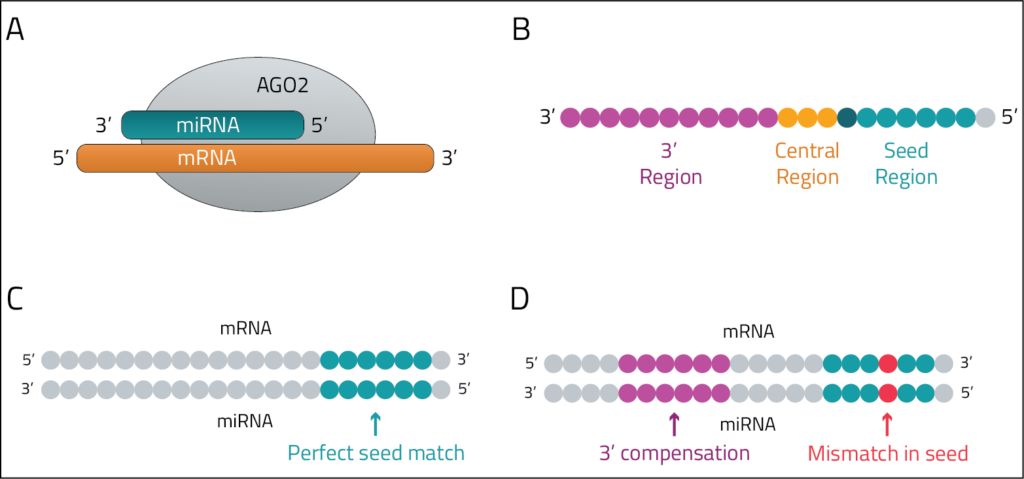miRNAs are small noncoding RNAs that regulate expression of their target transcripts. They are loaded into the RISC complex and target mRNAs based on perfect complementarity to their 5’ seed region (canonical binding) or through compensatory binding at the 3’ end (noncanonical binding)1. Their expression and activity is typically cell type or tissue dependent, limiting the ability of computational prediction methods to validate if a given miRNA is active in a given system. Understanding of binding and specific targets can help lead to advances in disease treatments, such as appropriate design of anti-miRs or avoiding competition with siRNAs.

Figure 1: miRNAs bind to and regulate mRNAs. A. A miRNA binds in an antisense direction to its target mRNA within AGO2. B. miRNA regions including the seed region where canonical binding to the target mRNA occurs, the central region which can be involved in centered binding, and the 3' region involved in compensatory and supplementary binding. C. An example of canonical miRNA binding where a perfect match between the miRNA seed region and the mRNA leads to regulation. D. An example of noncanonical binding where a mismatch in the seed region is compensated for by binding in the 3' region.
miR-eCLIP+ reveals miRNA and siRNA binding
Our miR-eCLIP+ assay identifies direct miRNA-mRNA interactions transcriptome-wide, providing information on validated miRNA activity. The miR-eCLIP+ protocol begins with crosslinking of cells or cryoground tissue samples, followed by lysis and RNA fragmentation. RNA molecules bound to AGO2, a key member of RISC, are isolated using a AGO2-specific antibody, and an added ligation step forms chimeric molecules where each chimera contains both a miRNA and its mRNA target. We then perform library preparation, resulting in a next-generation sequencing library that contains validated miRNA-mRNA interaction data including chimeric reads. For our partners examining a particular miRNA or gene of interest, we can use probes to enrich for a specific sequence for increased coverage.

Figure 2: Overview of the miR-eCLIP+ assay. The RISC complex is crosslinked and immunoprecipitated with an antibody specific to AGO2. Reads are then chimerically ligated and next-generation sequencing libraries are generated where the final reads contain the miRNA sequence and the sequence of its mRNA target. This read structure then allows direct identification of each miRNA, its target, and where it is binding.
miR-eCLIP+ offers advantages over computational prediction methods such as TargetScan2. These methods typically focus on targets that contain a match to the seed region in the target’s 3’ UTR, where the seed region is typically defined as nucleotides 2-7 or 2-8 of the mature miRNA sequence. However, miRNAs can bind without full complementarity to the seed sequence or to other gene regions such as the coding exons. In addition, any output from one of these algorithms is a prediction and requires further experiments to validate that the binding occurs in a given cell type. With miR-eCLIP+, we identify targets that bind due to complementarity to other portions of the miRNA as well as targets that do not contain any seed match. Due to the ligation between the miRNA and the mRNA, the assay provides direct information on miRNA activity, limiting the need for subsequent validation experiments.
miR-eCLIP+ can also be utilized to identify siRNA-mRNA interactions. miR-eCLIP+ can also identify siRNA off-targets and reveal differential targeting between multiple siRNA candidates. Analysis of siRNA chimeric reads can reveal alternative processing of siRNAs as well as indicate where the siRNA binds to its off-targets, regardless of whether the binding occurs in the canonical seed region. These features make miR-eCLIP+ an invaluable tool for siRNA design and screening.
Eclipsebio supports your research and drug development goals
At Eclipsebio, we are excited to help further your scientific discoveries and support siRNA and anti-miR drug development. Contact us today for more information about running a miR-eCLIP+ experiment in your sample type of choice.
References
Latest eBlogs
RNA advancements and innovations: A 2025 review
In this latest eBlog, the Eclipsebio team looks back to some of the year's breakthroughs and ahead to future innovations.
State of Eclipsebio – 2025
In this Thanksgiving-themed blog, our CEO reflects on the past year at Eclipsebio and looks forward to 2026.
